Oryol
| Oryol (English) Орёл (Russian) | |
|---|---|
| - City[1] - | |
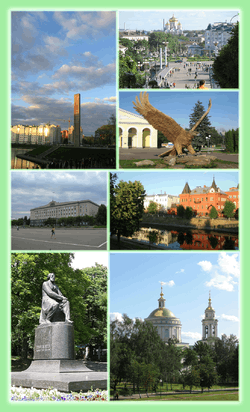 Views of Oryol | |
.svg.png) Location of Oryol Oblast in Russia | |
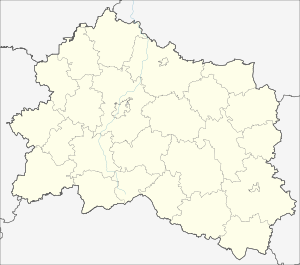 Oryol | |
|
| |
_(1781).png) |
|
|
| |
| City Day | August 5 |
| Administrative status (as of April 2011) | |
| Country | Russia |
| Federal subject | Oryol Oblast[1] |
| Administratively subordinated to | city of oblast significance of Oryol[1] |
| Administrative center of | Oryol Oblast,[1] city of oblast significance of Oryol,[1] Orlovsky District[1] |
| Municipal status (as of May 2010) | |
| Urban okrug | Oryol Urban Okrug[2] |
| Administrative center of | Oryol Urban Okrug,[2] Orlovsky Municipal District[3] |
| Mayor | Sergey Stupin[4] |
| Statistics | |
| Area | 127.8 km2 (49.3 sq mi)[5] |
| Population (2010 Census) | 317,747 inhabitants[6] |
| - Rank in 2010 | 57th |
| Density | 2,486/km2 (6,440/sq mi)[7] |
| Time zone | MSK (UTC+03:00)[8] |
| Founded | 1566 |
| City status since | 1702 |
| Postal code(s)[9] | 302000–302999 |
| Dialing code(s) | +7 4862 |
|
| |
| Oryol on Wikimedia Commons | |
Oryol or Orel (Russian: Орёл; IPA: [ɐˈrʲɵl], lit. eagle) is a city and the administrative center of Oryol Oblast, Russia, located on the Oka River, approximately 360 kilometers (220 mi) south-southwest of Moscow. Population: 317,747 (2010 Census);[6] 333,310 (2002 Census);[10] 336,862 (1989 Census).[11]
History

While there are no historical records, archaeological evidence shows that a fortress settlement existed between the Oka and Orlik Rivers as early as the 12th century, when the land was a part of the Principality of Chernigov. The name of the fortress is unknown; it may not have been called Oryol at the time. In the 13th century the fortress became a part of the Zvenigorod district of the Karachev Principality. In the early 15th century, the territory was conquered by the Grand Duchy of Lithuania. The city was soon abandoned by its population, after being sacked either by Lithuanians or the Golden Horde. The territory became a part of the Tsardom of Russia in the 16th century.
Ivan the Terrible decreed that a new fortress be built on the spot in 1566, for the purpose of defending the southern borders of the country. The fortress was built very speedily, work starting in the summer of 1566 and ending in the spring of 1567. The location chosen was less than ideal strategically, as the fortress was located on a seasonally flooded low ground easily targeted from the neighboring high ground. False Dmitry I and his army passed through Oryol in 1605; Ivan Bolotnikov in 1606; False Dmitry II camped in Oryol for the winter of 1607–1608. Polish intervention sacked it in 1611 and 1615; the population fled after the second sacking and moved to Mtsensk. Orlovsky Uyezd nonetheless continued to exist on paper.
Oryol was rebuilt in 1636. The question of moving the fortress to the more advantageous high ground was in the air up until the 1670s, but the move was never made. The fortress was deemed unnecessary and taken apart in the early 18th century.
In the mid-18th century Oryol became one of the major centers of grain production, with the Oka River being the major trade route until the 1860s when it was replaced by a railroad.
Oryol was granted town status in 1702. In 1708, Oryol was included as a part of Kiev Governorate; in 1719, Oryol Province was created within Kiev Governorate. The Province was transferred to the newly created Belgorod Governorate in 1727. On March 11 (February 28 old style), 1778 Oryol Vice-Royalty was created from parts of Voronezh and Belgorod Governorates. In 1779, the city was almost entirely rebuilt based on a new plan; and the Oryol River was renamed Orlik (lit: "little eagle").
After the October Revolution of 1917, the city was in Bolshevik hands, except for a brief period between October 13 and October 20, 1919, when it was controlled by Anton Denikin's White Army.
Oryol was once again moved between different oblasts in the 1920s and 1930s (at first as Oryol Governorate until 1928, then Central Black Earth Region between 1928 and 1934, finally in Kursk Oblast), finally becoming the administrative center of its own Oryol Oblast on September 27, 1937.
The Oryol Prison was a notable place of incarceration for political prisoners and war prisoners of the Second World War. Christian Rakovsky, Maria Spiridonova, Olga Kameneva and 160 other prominent political prisoners were shot on September 11, 1941 on Joseph Stalin's orders in the Medvedev forest outside Oryol.
During World War II, Oryol was occupied by the Wehrmacht on October 3, 1941, and liberated on August 5, 1943, after the Battle of Kursk. The city was almost completely destroyed.
Politics
In February 2012, the city duma abolished the direct election of mayor. In December 2013, a referendum was held, which 71% of the people supported the return of direct mayoral election.[12]
Administrative and municipal status
Oryol is the administrative center of the oblast and, within the framework of administrative divisions, it also serves as the administrative center of Orlovsky District, even though it is not a part of it.[1] As an administrative division, it is incorporated separately as the city of oblast significance of Oryol—an administrative unit with the status equal to that of the districts.[1] As a municipal division, the city of oblast significance of Oryol is incorporated as Oryol Urban Okrug.[2]
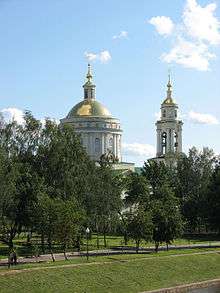
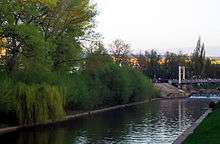
Transportation
The city is served by the Oryol Yuzhny Airport. Since 1868, there has been a railway connection between Oryol and Moscow.[13]
Oryol is a major transport hub on the borders of the Central and Central Black Earth economic regions. Through the city converge 7 important highways of federal and republican values: M2 (E 105), P92, R119, R120, A142 (E93), 5 railway lines: on Yelets, Moscow, Kursk, Bryansk, Mikhailovsky mine. The city has an airport (currently (2013) does not work). The formation of the Oryol as an important transportation hub is due to the favorable geographical position of the city on the borders of economic regions.
The town has trolley, tram and bus systems. These kinds of public transport cover the entire territory of the city. Each bus, tram and trolley is equipped with route indicators that inform about the route through the city, designated stops. There is also a waterbus on the Oka River. In the city there are taxis and shuttles, and rental cars. Intercity transport terminals: Oryol Station, Station Luzhki-Oryol, Oryol Bus Station, as well as federal highway M2 (E 105), P92, R119, R120, A142.
Tram
On November 3, 1898 Orel inaugurated an electric tram. The draft was prepared by the Belgian entrepreneur FF Gilon and firm «Compagnie mutuelle de tramways», which won the right to build not only a tram, but also lighting in the city.
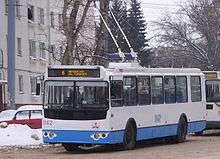 ZiU-682 trolleybus
ZiU-682 trolleybus Tatra T3SU tram
Tatra T3SU tram
Climate
Oryol has a humid continental climate (Köppen climate classification Dfb).
| Climate data for Oryol | |||||||||||||
|---|---|---|---|---|---|---|---|---|---|---|---|---|---|
| Month | Jan | Feb | Mar | Apr | May | Jun | Jul | Aug | Sep | Oct | Nov | Dec | Year |
| Record high °C (°F) | 8.0 (46.4) |
9.4 (48.9) |
18.2 (64.8) |
27.8 (82) |
32.8 (91) |
35.4 (95.7) |
38.7 (101.7) |
39.5 (103.1) |
30.7 (87.3) |
26.3 (79.3) |
16.0 (60.8) |
9.6 (49.3) |
39.5 (103.1) |
| Average high °C (°F) | −3.7 (25.3) |
−3.6 (25.5) |
2.3 (36.1) |
12.2 (54) |
19.5 (67.1) |
22.9 (73.2) |
24.9 (76.8) |
23.7 (74.7) |
17.3 (63.1) |
10.1 (50.2) |
1.9 (35.4) |
−2.7 (27.1) |
10.4 (50.7) |
| Daily mean °C (°F) | −6.3 (20.7) |
−6.7 (19.9) |
−1.3 (29.7) |
7.2 (45) |
13.9 (57) |
17.5 (63.5) |
19.3 (66.7) |
17.9 (64.2) |
12.1 (53.8) |
6.1 (43) |
−0.8 (30.6) |
−5.1 (22.8) |
6.2 (43.2) |
| Average low °C (°F) | −9 (16) |
−9.9 (14.2) |
−4.7 (23.5) |
2.6 (36.7) |
8.4 (47.1) |
12.2 (54) |
14.1 (57.4) |
12.7 (54.9) |
7.6 (45.7) |
2.7 (36.9) |
−2.8 (27) |
−7.7 (18.1) |
2.2 (36) |
| Record low °C (°F) | −33.5 (−28.3) |
−37.2 (−35) |
−37.8 (−36) |
−18.9 (−2) |
−5 (23) |
−0.4 (31.3) |
3.9 (39) |
−2.2 (28) |
−5 (23) |
−13 (9) |
−26.4 (−15.5) |
−35 (−31) |
−37.8 (−36) |
| Average precipitation mm (inches) | 43 (1.69) |
37 (1.46) |
33 (1.3) |
43 (1.69) |
42 (1.65) |
69 (2.72) |
76 (2.99) |
59 (2.32) |
60 (2.36) |
54 (2.13) |
42 (1.65) |
43 (1.69) |
601 (23.66) |
| Average snowfall cm (inches) | 15 (5.9) |
21 (8.3) |
21 (8.3) |
10 (3.9) |
7 (2.8) |
0 (0) |
0 (0) |
0 (0) |
0 (0) |
3 (1.2) |
6 (2.4) |
7 (2.8) |
90 (35.6) |
| Average precipitation days | 23 | 20 | 17 | 12 | 10 | 11 | 8 | 8 | 11 | 14 | 17 | 24 | 175 |
| Average relative humidity (%) | 84 | 81 | 75 | 65 | 64 | 69 | 71 | 69 | 77 | 82 | 86 | 87 | 75.8 |
| Mean monthly sunshine hours | 34.1 | 67.2 | 133.3 | 186.0 | 269.7 | 273.0 | 288.3 | 275.9 | 168.0 | 89.9 | 36.0 | 31.0 | 1,852.4 |
| Source: Pogoda.ru.net[14] | |||||||||||||
Mayors
- 1991–1997: Alexander Kislyakov
- 1997–2002: Yefim Velkovsky
- 2002–2006: Vasily Uvarov
- 2006–2009: Alexander Kasyanov
- 2009–2010: Vasily Eremin
- 2010–2012: Viktor Safianov
- 2012: Mihail Bernikov
- 2012–present: Sergey Stupin
International relations
Twin towns and sister cities
Oryol is twinned with:
-
 Brest, Belarus
Brest, Belarus -
 Kerch, disputed Russia/Ukraine
Kerch, disputed Russia/Ukraine -
 Leeuwarden, Friesland, Netherlands
Leeuwarden, Friesland, Netherlands -
 Nokia, Finland
Nokia, Finland -
 Razgrad, Bulgaria (since 1968)
Razgrad, Bulgaria (since 1968) -
 Offenbach am Main, Germany (since 1988)[15]
Offenbach am Main, Germany (since 1988)[15]
Notable people
- Leonid Andreyev, playwright
- Mikhail Bakhtin, literary critic[16]
- Fedor Baranov, fisheries scientist
- Denis Boytsov, boxer
- Felix Dzerzhinsky, statesman
- Afanasy Fet, poet
- Nikolai Getman, painter and Gulag survivor
- Timofey Granovsky, historian
- Vasily Kalinnikov (1866-1901), composer
- Yakov Kasman, pianist
- Anna Petrovna Kern, socialite
- Stanislav Lebamba, association football player
- Nikolai Leskov, novelist
- Denis Menchov, cyclist
- Artem Mikoyan, founder of the MiG aircraft manufacturer
- Fritz Noether, mathematician
- Nikolai Nikolaevich Polikarpov, aviation designer
- Yevgeni Preobrazhensky, statesman
- Vladimir Karlovich Roth, neuropathologist
- Valerian Safonovich, statesman
- Alexey Stakhanov, worker
- Pyotr Stolypin, statesman
- Yakov Sverdlov, Bolshevik revolutionary
- Ivan Turgenev, novelist and playwright
- Aleksey Petrovich Yermolov, military general
- Gennady Zyuganov, politician
References
Notes
- 1 2 3 4 5 6 7 8 Law #522-OZ
- 1 2 3 Law #467-OZ
- ↑ Law #466-OZ
- ↑ http://www.orelgorsovet.ru/p1009.html
- ↑ БД ПМО Орловской области. Город Орёл
- 1 2 Russian Federal State Statistics Service (2011). "Всероссийская перепись населения 2010 года. Том 1" [2010 All-Russian Population Census, vol. 1]. Всероссийская перепись населения 2010 года (2010 All-Russia Population Census) (in Russian). Federal State Statistics Service. Retrieved June 29, 2012.
- ↑ The value of density was calculated automatically by dividing the 2010 Census population by the area specified in the infobox. Please note that this value may not be accurate as the area specified in the infobox does not necessarily correspond to the area of the entity proper or is reported for the same year as the population.
- ↑ Правительство Российской Федерации. Федеральный закон №107-ФЗ от 3 июня 2011 г. «Об исчислении времени», в ред. Федерального закона №271-ФЗ от 03 июля 2016 г. «О внесении изменений в Федеральный закон "Об исчислении времени"». Вступил в силу по истечении шестидесяти дней после дня официального опубликования (6 августа 2011 г.). Опубликован: "Российская газета", №120, 6 июня 2011 г. (Government of the Russian Federation. Federal Law #107-FZ of June 31, 2011 On Calculating Time, as amended by the Federal Law #271-FZ of July 03, 2016 On Amending Federal Law "On Calculating Time". Effective as of after sixty days following the day of the official publication.).
- ↑ Почта России. Информационно-вычислительный центр ОАСУ РПО. (Russian Post). Поиск объектов почтовой связи (Postal Objects Search) (Russian)
- ↑ Russian Federal State Statistics Service (May 21, 2004). "Численность населения России, субъектов Российской Федерации в составе федеральных округов, районов, городских поселений, сельских населённых пунктов – районных центров и сельских населённых пунктов с населением 3 тысячи и более человек" [Population of Russia, Its Federal Districts, Federal Subjects, Districts, Urban Localities, Rural Localities—Administrative Centers, and Rural Localities with Population of Over 3,000] (XLS). Всероссийская перепись населения 2002 года [All-Russia Population Census of 2002] (in Russian). Retrieved August 9, 2014.
- ↑ Demoscope Weekly (1989). "Всесоюзная перепись населения 1989 г. Численность наличного населения союзных и автономных республик, автономных областей и округов, краёв, областей, районов, городских поселений и сёл-райцентров" [All Union Population Census of 1989: Present Population of Union and Autonomous Republics, Autonomous Oblasts and Okrugs, Krais, Oblasts, Districts, Urban Settlements, and Villages Serving as District Administrative Centers]. Всесоюзная перепись населения 1989 года [All-Union Population Census of 1989] (in Russian). Институт демографии Национального исследовательского университета: Высшая школа экономики [Institute of Demography at the National Research University: Higher School of Economics]. Retrieved August 9, 2014.
- ↑ "В Орле голосуют за возвращение прямых выборов мэра". Rossiyskaya Gazeta. December 10, 2013. Retrieved 25 January 2014.
- ↑ Train Station in Oryol (Russian)
- ↑ "Pogoda.ru.net" (in Russian). Retrieved September 8, 2007.
- ↑ "Offenbach und seine Partnerstädte". City of Offenbach. 21 April 2010. Retrieved 25 September 2016.
- ↑ David Lodge, After Bakhtin: Essays on Fiction and Criticism, London & New York: Routledge, 1990, p. 1
Sources
- Орловский областной Совет народных депутатов. Закон №522-ОЗ от 6 июля 2005 г. «Об административно-территориальном устройстве Орловской области», в ред. Закона №1187-ОЗ от 1 апреля 2011 г «О внесении изменений в законодательные акты Орловской области». Вступил в силу с момента официального опубликования. Опубликован: "Орловская правда", №116, 13 июля 2005 г. (Oryol Oblast Council of People's Deputies. Law #522-OZ of July 6, 2005 On the Administrative-Territorial Structure of Oryol Oblast, as amended by the Law #1187-OZ of April 1, 2011 On Amending the Legislative Acts of Oryol Oblast. Effective as of the moment of the official publication.).
- Орловский областной Совет народных депутатов. Закон №467-ОЗ от 28 декабря 2004 г. «О статусе и границе города Орла как муниципального образования Орловской области», в ред. Закона №1059-ОЗ от 11 мая 2010 г «О внесении изменений в Закон Орловской области "О статусе и границе города Орла Орловской области"». Вступил в силу со дня официального опубликования. Опубликован: "Орловская правда", №233, 30 декабря 2004 г. (Oryol Oblast Council of People's Deputies. Law #467-OZ of December 28, 2004 On the Status and Borders of the City of Oryol as a Municipal Formation of Oryol Oblast, as amended by the Law #1059-OZ of May 11, 2010 On Amending the Law of Oryol Oblast "On the Status and Borders of the City of Oryol of Oryol Oblast". Effective as of the day of the official publication.).
- Орловский областной Совет народных депутатов. Закон №466-ОЗ от 28 декабря 2004 г. «О статусе, границах и административных центрах муниципальных образований на территории Орловского района Орловской области», в ред. Закона №1327-ОЗ от 2 марта 2012 г. «О внесении изменений в Закон Орловской области "О статусе, границах и административных центрах муниципальных образований на территории Орловского района Орловской области" и признании утратившими силу отдельных положений Закона Орловской области "О внесении изменений в Закон Орловской области "О статусе, границах и административных центрах муниципальных образований на территории Орловского района Орловской области"». Вступил в силу со дня официального опубликования. Опубликован: "Орловская правда", №233, 30 декабря 2004 г. (Oryol Oblast Council of People's Deputies. Law #466-OZ of December 28, 2004 On the Status, Borders, and Administrative Centers of the Municipal Formations on the Territory of Orlovsky District of Oryol Oblast, as amended by the Law #1327-OZ of March 2, 2012 On Amending the Law of Oryol Oblast "On the Status, Borders, and Administrative Centers of the Municipal Formations on the Territory of Orlovsky District of Oryol Oblast" and on Rescinding Parts of the Law of Oryol Oblast "On Amending the Law of Oryol Oblast "On the Status, Borders, and Administrative Centers of the Municipal Formations on the Territory of Orlovsky District of Oryol Oblast". Effective as of the day of the official publication.).
External links
- Official website of Oryol (Russian)
- Unofficial website of Oryol (Russian)
- The murder of the Jews of Oryol during World War II, at Yad Vashem website.